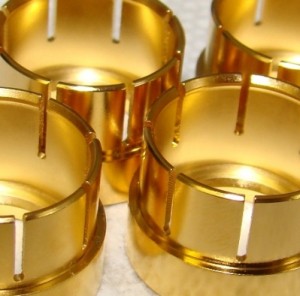For most people, it’s easy to confuse gold plated with gold overlay. After all, they do sound similar.
You may be surprised to find out, however, that each term carries very different meanings. If you’re one that sells or buys gold, it’s important to understand the distinction between the two, the biggest being layer thickness.
There are also a few other terms you should know about as well, such as gilding, gold layered, and gold filled.
Gold Plated
Gold plating is the practice of applying a very thin layer of gold onto the surface of an object through a process called electroplating. It gives the object a gold-like appearance and also renders it more desirable for the gold-like properties.
Gold plating is a common practice especially in today’s electronics industry. Semiconductors, circuit boards and audio jacks are just a few of the products people tend to see all the time that use gold plated hardware.
It’s especially popular in the jewelry industry because it gives you a product that resembles gold, but without the high price.
A few specifications for “Gold Plated”:
- Gold must be at least 7 millionths of an inch thick.
- Gold must be of at least 10k quality.
Gold Layered
A gold layered object is similar to gold plated, but it differs in that there is no Federal standard for “gold layered”, so a gold layered object could have as little as 1 millionths of an inch of gold plating on it. That’s a super thin layer!
Gilding
You may have heard the term gilt before. A gilt is used to describe a gilded object. Traditionally, gilding has been largely used for decoration. It is the practice of applying fine gold powder or gold leaf to hard surfaces such as wood, stone or metal without the use of electric current.
Gold Overlay
An object with gold overlay has a thicker coating that will hold up better over time and is usually more valuable gold plated objects. The technique has been around for thousands of years and used all over the world. It is the process of using heat and pressure to forge a new alloy with base metals, usually brass.
Because nickel is not used in overlay, rings and other jewelry with gold overlay do not irritate the skin like some gold plated jewelry items do.
A few specifications for “Gold Overlay”:
- The weight of the gold can be less than 1/20th the weight of the metal.
- A stamp indicating overlay quality must be carried on the object.
Gold Filled
Gold overlay and gold filled are similar in that they both use heat and pressure, but they differ for the reasons listed below.
A few specifications for “Gold Filled”:
- Must have an overlay of at least 10k gold and weigh at least 1/20th of the total weight of the metal.
- A stamp indicating filled quality must be carried on the object.
If you have an object that is gold plated and you’re looking to sell it to a gold buyer near you, you may be surprised to find out that the gold layer doesn’t add any value to your object. On the other hand, if you have an item that is gold filled or overlayed, then you’re in better luck.
So how do you know what kind of coating you have? Without a quality stamp on the item, you won’t be able to tell using the naked eye whether your product is gold plated or overlay. X-ray Fluorescence is one way to measure coating thickness.
There you have it. Hopefully you have a better idea of the similarities and differences between different gold plating/overlay. We always look forward to hearing from you. Leave your comments below!


